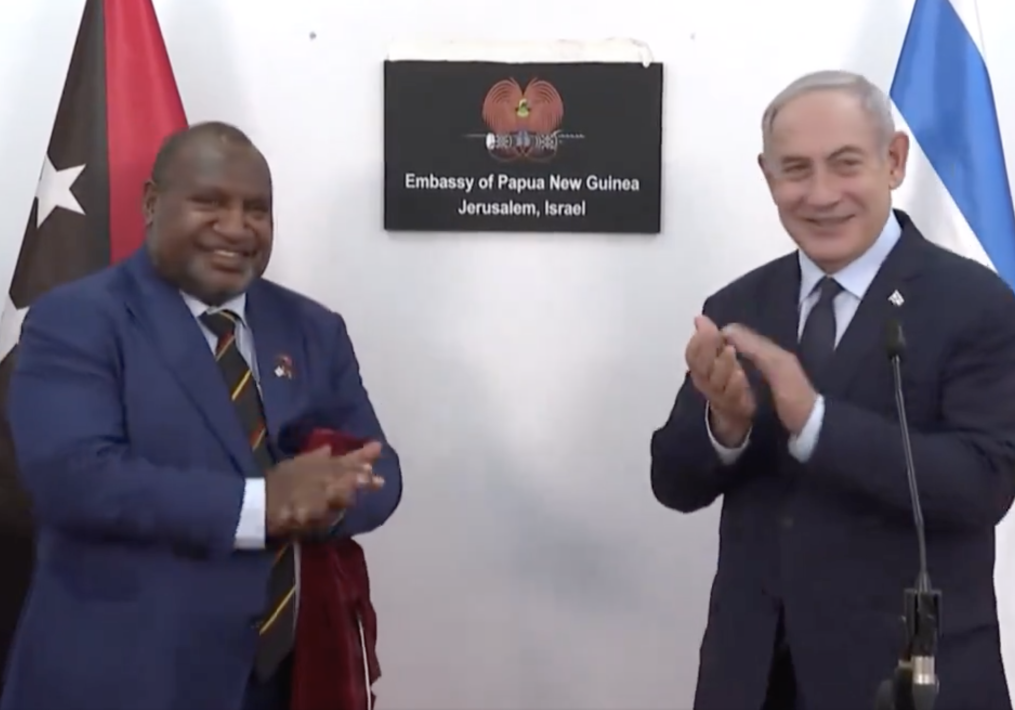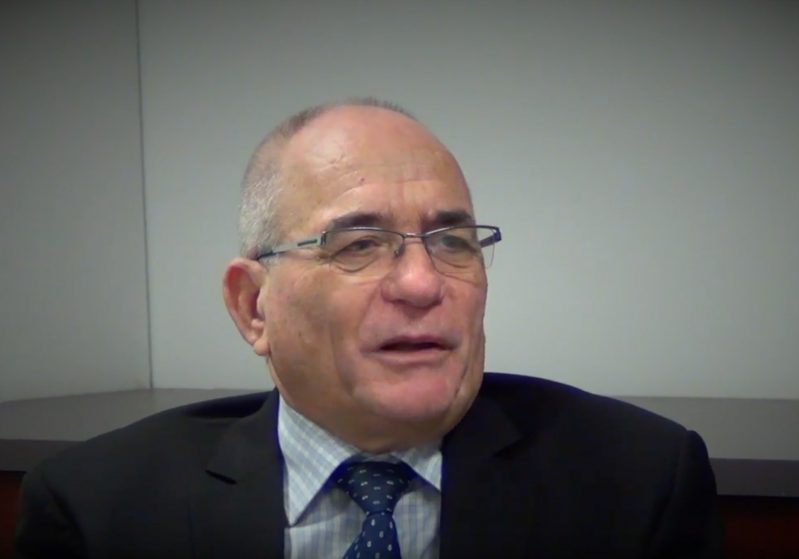Australia/Israel Review
Biblio File: Pride of Lyons – A journey to an imaginary “evil empire”
Nov 10, 2017 | Douglas Davis

Douglas Davis
(From the November 2017 edition of the Australia/Israel Review)
Balcony Over Jerusalem
by John Lyons, with Sylvie Le Clezio, Harper Collins, 374 pp. $34.99
Pity John Lyons. This courageous lion of journalism not only had to endure a study tour of Israel run by the pro-Israel lobby at the NSW Jewish Board of Deputies but also a six-year posting to that most evil of evil empires by the Australian. Did he use the opportunity of the study tour to expand his knowledge of Israel and fill his contact book with the names and numbers of the country’s top academics, politicians and military brass whom he surely encountered there? Oh no, he saw through this cunning ploy by the lobby, with its cosmic powers to subvert and corrupt.
The Melbourne-based lobby, AIJAC, had “convinced the majority of the media” to falsely portray Israel as the victim of the conflict, said Lyons, a pure product of the Christian Brothers’ College St Kilda (as we are repeatedly reminded). But he, bravely, would not be sucked into the conspiracy.
To some extent, this memoir seems to be more about settling scores than anything else – getting even with Israel, but mostly with AIJAC: he would make the manipulative lobby pay for its attempt to suborn his formidable skills and pervert the exquisite intelligence that guide his fingers across the computer keyboard. Instead, he would turn his skills against AIJAC for supposedly hoodwinking so many of his media colleagues. How repulsed was he by the duplicity of the lobby’s plot; by its iniquitous attempts to poison the well of truth and snatch away the media’s sensitive innocence.
In fact, like most senior journalists, John Lyons must have encountered dozens of lobbies on a daily basis, all seeking attention for their product and all attempting to persuade him of their particular view. Almost every issue has its lobby. Incidentally, I consider lobbies – whether pro-abortion or anti-smoking – to be good for democracy. They are the essential components for debate in the noisy marketplace of ideas.
Reading Lyons’s vituperations about AIJAC, I was reminded of a visit I made to Belfast and Dublin in the early ’90s at the request of the Australian (before that, I had preceded John Lyons as the paper’s Jerusalem-based Middle East correspondent for five years). The Belfast visit was arranged and conducted by the Northern Ireland Office, a ministry within the British government, which definitely sought to convey a point of view and could, therefore, be classed as a lobby. The visit occurred at the height of “the Troubles” and I was taken on a comprehensive tour of Belfast, including its “Peace Walls”. Call it a study tour. I had breakfast with the Minister at Stormont Castle and met a raft of British government officials, including senior intelligence and military officers, and, among others, a man whose job it was to travel from one business to another to ensure equality in employment for Catholics and Protestants.
But meetings with Sinn Fein or the IRA were strictly beyond the limits of their hospitality. Period. I appreciated that British government largesse did not extend to facilitating meetings with the “other side”. So I found myself a “fixer”, a well-connected Catholic taxi driver in Belfast, who filled in the gaps and introduced me to the world of Sinn Fein, the IRA and their officials (though not before pulling a gun on me during our drive from Belfast to Dublin to demand that I produce a press card).
The efforts of the Northern Ireland Office, limited as they were, proved to be useful, as did my Catholic “fixer”. Such are the travails of the journalist in conflict zones – and the limited value of lobbies. But I was not without my own resources and independently set up meetings with officials at the Foreign Ministry in Dublin. I would judge AIJAC to be a more sophisticated and comprehensive operation than was the Northern Ireland Office. [Ed. Note: AIJAC study visits do routinely include meetings with Palestinian representatives.]
Some may regard John Lyons as the luckiest man in the world to have been posted to the most exciting country on earth; a place of extraordinary vitality, creative exuberance, cutting-edge science, high-tech innovation, a super-abundance of intellectual energy; an open, democratic nation guided by the rule of law; a somewhat anarchic, multi-racial, multi-faith, multi-ethnic, multi-lingual society that welcomes debate and – yes – dissent. It is also a goldmine of material for journalists, who are free to go where they like, meet whom they like and pick up the phone to whoever they choose at whatever time of the day or night (particularly useful when writing for the Australian, whose deadlines are at four or five in the morning, Israel time).
But Lyons seems content to have observed the Middle East from the five-star luxury of an affluent Jerusalem suburb and from his air-conditioned car, always in a permanent huff of righteous indignation. How much richer might the experience have been if he had planted his inquisitive mind in the rewarding cities of Ramallah or Nablus. Or Damascus, or Baghdad, or Sana’a, or Tripoli, or even Cairo, where the real news stories of the Middle East have been played out over the past decade or so. Pity John Lyons, a lightweight intent on proving his credentials among the heavyweights labouring in the tangled vineyards of the Middle East.
Israel might seem monochromatic to the short-term, half-blind visitor. But to those who are sharp eyed, it is the most variegated place on the planet: a profusion of colour and light, sounds and tastes, people and places, institutions and ideas. One of the finest foreign correspondents to have covered the country, David Shipler, of The New York Times, described it as being like an onion. Every layer you peel produces some new and fascinating revelation or insight. Shipler was alone in breaking military censorship to publish a report about the capture and killing of two Palestinian bus hijackers, an event that gave rise to national breast-beating and the insistence of the Israel Defence Forces in re-instilling the concept of “purity of arms” into its conscripts. Shipler won a Pulitzer Prize for Arab and Jew: Wounded Spirits in a Promised Land, his book on his stint in Israel, from 1979 to 1984, which is a fascinating exploration into Arab-Jewish perceptions and relations in Israel and the West Bank.
Another fine book, Holy Land Unholy War, was written by Anton La Guardia, the Jerusalem-based Middle East correspondent of the Daily Telegraph from 1990 to 1998 and now a senior staffer on the Economist. Like Shipler, his knowledge and sensitivity – his quest for dispassion and objectivity – evoked unease, even anger, but ultimately won respect on both sides of the divide. La Guardia makes the interesting observation that, “the response of visitors to Israel and Palestine over the past century has said as much about the observer as about the country itself”. To La Guardia, “the conflict over the Holy Land – or Israel, or Palestine – is a vast story of tragedy and redemption… There is a constant moral tension about the place – the survival of the ancient amidst the new, the superposition of the religious and the profane, the sullying of the spiritual with the brutal, the discordance between epic heroism and pettiness.”
These are but two out of a large library of books by Middle East veterans. Where does Lyons fit in the pantheon? Well, he doesn’t. The account of his six years in Jerusalem does not belong in the rich oeuvre of work produced by the many distinguished journalists who lived in Israel and came to appreciate the complexities that make it a multi-coloured, three-dimensional story, with blame and praise on both sides; sometimes approaching the aspirations of those who willed it into being, mostly not. Lyons has produced a work of mundane thought and banal language, not the qualities of a high-grade journalist. Indeed, some may not actually regard John Lyons as a fully-fledged journalist in the conventional sense, but rather as a sort of aid worker cum human rights monitor cum partisan propagandist cum blogger.
Adrift in his unfathomable loathing of Israel is an absence of any serious contextual overview of Jerusalem, a city which has, since its founding by King David 3,000 years ago, been ruled by Jews, Greeks, Romans, Arabs, Christians, Persians and Turks – and of the fact that it was only in 1994, under Israeli rule, that the Palestinian flag was raised there for the first time.
Missing are the real stories of the real people who inhabit this infuriatingly fractious land, the texture of the place, still less the great historical context in which this most extraordinary modern drama is unfolding. Instead, the reader is confronted with cardboard cut-outs of infantilised goodies and uncaring baddies with the author taking sides, eyes peeled, ears cocked, pen poised.
He notes, somewhat pompously, that, “I’ve always had the view as a journalist that each story, each government and each country should be judged on its merits.” As a journalist, I have never felt the portentous need to pass judgement on governments or countries. Stories are another matter.
There is a glaring omission from John Lyons’ account that I simply cannot comprehend. How could a graduate of the Christian Brothers’ College, St Kilda, ignore the plight of Christians in the Middle East generally, and in the West Bank and Gaza particularly?
When I visited the then-Mayor of Bethlehem, Elias Freij, in the late ’70s, he happily boasted that about three-quarters of the population of his town, the birthplace of Christianity, was Christian. Today, after a reign of land-theft, intimidation, beatings and killings by newly arrived Islamic extremists following Yasser Arafat’s return to the Palestinian areas of the West Bank and Gaza Strip, the Christian population of Bethlehem is estimated to be down to10% – and falling. The ancient Christian population of Bethlehem, under pressure from the new Muslim majority, is quietly finding safer havens in those places where émigrés are permitted to strike root.
Bethlehem is a microcosm of a phenomenon that is evident throughout the West Bank and Gaza Strip. Against a drumbeat of harassment, which has included calls by Muslim extremists to slaughter their Christian neighbours, half of the Palestinian Christians in the Gaza Strip fled their homes following the 2007 Hamas putsch. In the West Bank, Christians, who once accounted for 15 per cent of the population, are now down to less than 2 per cent. It should be noted that since Israel was established – the only state in the region to guarantee freedom of worship to all faiths – the Arab Christian population has increased by an estimated 2,000 per cent.
What baffles me is why John Lyons is relatively silent in the face of this apartheid-style oppression that persists in the Arab world. Why does he not speak out and demonstrate in solidarity with his fellow Christians?
The questions persist: Why did John Lyons find AIJAC, a highly competent organisation with a sensitive, well-informed staff, to be so ubiquitously, uniquely evil? Why did he feel it necessary to make such heavy weather of his Middle East posting? And why did he ignore the plight of women, ethnic minorities and other faiths? Such questions, perhaps, should be referred to a professional who deals in matters of human psychology.
I can only offer here a small fraction of the many factual inaccuracies and factually misleading statements I encountered in Lyons’ account. “Neve Shalom”, for example, is the Hebrew term for “Oasis of Peace”, not the “New Peace”, as he guesses in Chapter 4. Moreover Lyons claims that by the time he returned to Israel in 2009, “almost all” of the Israeli-Palestinian dialogues and student exchanges fostered by this Arab-Jewish village/organisation had “stopped.” This is simply untrue – the group continues to operate and present a huge range of peace-building and dialogue programs, as anyone can see by looking at their website, www.sfpeace.org.
Perhaps the most egregious and telling error in the book comes in Chapter 11, when Lyons tries to prove that Israel’s occupation of the West Bank in 1967 came as the result of not an accidental war but as a premeditated “ambition of taking over the West Bank as part of Greater Israel”. To prove this false claim, he asserts that “The master plan for Israel to take over the West Bank was formed by Yigal Alon [sic] when he was Minister of Labour in the early 1960s.” Lyons cites no source for this claim that Yigal Allon formulated his famous Allon plan for Israel to keep some parts of the West Bank before the 1967 war – probably because he cannot, since no reputable source I have found makes this claim. According to both recently-released cabinet documents and perhaps the most definitive history of Israel’s control of the West Bank, Gershom Gorenberg’s The Accidental Empire, Israel and the Birth of Settlements, Allon formulated his famous plan in the aftermath of the 1967 war, as common sense would dictate.
Lyons’ other major proof for his “the 1967 war was really about Greater Israel” thesis is also a factual misrepresentation. Lyons says, “In the documentary The Law in These Parts, former Supreme Court president Meir Shamgar states that laws for the West Bank were written in the early 1950s.” In fact, that documentary states nothing of the kind. It states that “years” before the 1967 war “IDF legal corps officers studied international law, the laws of war, and regulations of occupation of enemy territory. In those years, the Military Advocate General Meir Shamgar, wrote the ‘Guide for the Military Advocate in Occupied Territory,’ a booklet containing all information a military legal professional would need should the IDF ever occupy territory in a neighbouring country.” This document was certainly not produced in the 1950s because Shamgar did not take office until 1963. Moreover, the documentary says absolutely nothing about the Guide in question being written and intended for a planned future occupation of the West Bank, even if it was later adapted for that purpose – instead it was almost certainly intended to deal with a situation like Israel’s control of Sinai in 1956-57 for five months following the 1956 war.
Another smaller example, Lyons complains in Chapter 4 that his landlord Avi “reflected the view of many Israelis that the number of Palestinians in Jerusalem was increasing, when in fact it was falling.” But Avi was right and Lyons is just wrong. Palestinian numbers in Jerusalem are rising both in absolute terms and as a percentage of the population. There are currently more than 300,000 Palestinians in Jerusalem, up from 244,000 in 2005 and 208,000 in 2000. Meanwhile the Palestinian population of Jerusalem has risen from around 26% of the total in 1967 to 28% in 1980, 32% in 2000, and 37% in 2014.
Then there are Lyons’ repeated assertions that he knows that the Israeli population is really completely uninterested in a two-state peace and devoted to “Greater Israel”. Thus in Chapter 12, he says, “It was only by living among Israelis, mixing with them at the local sports club or over a Shabbat dinner, that we came to understand the endgame: formalising the occupation into official annexation and achieving Greater Israel.” And in Chapter 11, he not only says this is what Israelis want but implies that Israeli opinion actually wants to ethnically cleanse the West Bank of Palestinians, saying, “the majority of Israeli opinion now would be: ‘We’re there and it’s ours. The Palestinians should find somewhere else to live.'” Needless to say, this flies in the face of numerous Israeli public opinion polls, which Lyons never tells readers – though he does repeatedly cite public opinion polls, sometimes distorting their actual meaning, when it serves his purpose of portraying Israelis as racist and extremists.
One could go on and on:
In Chapter 14, Lyons misrepresents what Obama said during a speech to Israelis during his 2013 visit, saying he told them the IDF was “a foreign army” in the West Bank and this claim “stun[ned] Israelis” and “hit Israeli leaders like a thunderbolt.” No, Obama said Palestinians view the situation that way, and there is no evidence the claim “stunned Israelis” – the statement was actually a major applause line of the speech – and no Israeli leaders expressed shock at Obama’s claim. Moreover, Lyons even gets the date of the speech wrong.
Also in Chapter 14, Lyons claims that New York Times columnist Thomas Friedman declared, “Shame on You, Israel” for trying to portray Barack Obama as “a Jew hater.” No, Friedman said “Shame on you” to anyone who claimed Obama was a “Jew hater”, he never said all of Israel, or the Israeli Government, was guilty of this.
In the same chapter, Lyons claims that “Israel stated that the reason it had initiated the 2014 Gaza War was to target Hamas tunnels.” No, Israel never claimed this. The war started before the tunnels became an issue, as the result of rocket fire. Once the war started, Israel claimed that the tunnels were the reason it needed to send IDF ground forces into limited ground incursions into Gaza.
Such errors litter Lyons’ narrative, such as it is. As he should well know, a journalist’s credibility hangs by a fragile thread. And in the face of such major lapses, that thread has been strained well past breaking point.
Mark Twain once observed that being dispassionate about the Holy Land was like being dispassionate about your wife and children. On reading John Lyons’ memoir, there is no doubt about his dedication to his wife or his devotion to his young son. But he demonstrates a distinct lack of dispassion when it comes to Israel and his mission there.
Wading through Lyons’ memoir reminded me of a recent encounter I had over a small, private dinner in London with a prince of the British Foreign Office, an illustrious retired British Ambassador not only to Israel but also to other highly sensitive states. He was at his most charming, expansive, bibulous best, his face alight with boyish exuberance as his adoring audience encouraged ever-more shocking indiscretions.
At one point, he turned to me: “You know, there is such a thing as legitimate antisemitism.”
Really?
“Oh yes,” he said. “When politicians come to office, they are surrounded by myriad problems. Problems, problems, problems. Then along come the Jews. And they bring solutions. They dazzle the newly installed political leaders with their money, contacts, ideas and energy. In thrall to all this, the politicians are transfixed by the Jews, who make problems go away.” “But” – and here he could not resist the temptation to take the leap beyond the bounds of decency – “there is a price to be paid: the Jewish lobby.
“I find it despicable, simply disgusting,” he said, adding somewhat fancifully: “You know, if it weren’t for the Jewish lobby in Washington, we might have a Middle East peace treaty by now.”
That, of course, is arrant nonsense. But so easily does one of the finest slip so casually into the oldest hatred.
It is well established that some of the most virulent antisemitism occurs in countries with the fewest Jews. The concept of “antisemitism without Jews” is not new. It was, indeed, a defining characteristic of the old East European Warsaw bloc. But no sooner had we got our head around the concept of “antisemitism without Jews” than the new antisemitism produced a new concept: “Antisemitism without Antisemites”.
The father of the phrase is the German writer and journalist Henryk Broder and the forum in which it was born was the Interior committee of the German Bundestag. The supposedly non-existent antisemites, Broder explained to the committee, are the phalanx of “progressive” academics, politicians and journalists who express unlimited hate of Israel and would boycott the state out of existence, but vehemently reject any suggestion that they are antisemitic.
Polite, sophisticated society has altered its vocabulary. Today they speak of “Zionists” and “lobby” rather than “Jews” and “conspiracy”. The words have changed, but the meaning retains a chilling familiarity.
The anti-Israel campaign that is sweeping so much of the West – into which oeuvre this book would comfortably fit – is carried on a cloud of irrational hatred and buoyed by a bizarre set of conspiratorial fantasies. Who can doubt, let alone question, that Israel is the new apartheid state and that Israelis are the new Nazis? The fact that Israeli soldiers – from privates to generals – do not regularly commit war crimes; that the Israeli army does not harvest Palestinian organs; that there are demonstrably no parallels between Israel’s vibrant multiracial democracy and the racist barbarity of the old apartheid South Africa (from which I was formally exiled)… all this cuts no ice. Nothing must be permitted to tarnish the pristine mythology that has been crafted around mythical Palestine.
Some people see what they want to see and hear what they want to hear. And what many, like Lyons, want to see and hear is “evidence” that serves to demonise and delegitimise Israel as the brutal aggressor.
What does all this mean? One American commentator summed it up succinctly when he declared that, “Israel is denounced not for what it does, but for what it is.” That opens a more chilling discussion with far more profound implications. We’re not talking about a demonstration here or a boycott there. The only way that Israel can satisfy these critics is, quite simply, by ceasing to exist.
Douglas Davis is a London-based writer and analyst specialising in Middle East and European affairs. He has lived and worked on four continents, and served as Middle East Correspondent for the Australian for more than five years in the late 1980s and early 1990s. He was also senior editor of the Jerusalem Post. He is co-author of Sharansky: The Journey Home (Harcourt Brace Jovanovich, New York); The New Antisemitism (Profile Books, London) and Israel in the World (Weidenfeld and Nicolson, London).
https://aijac.org.au/news/article/biblio-file-pride-of-lyons-a-journey-to-an-imagi
Tags: Australasia






